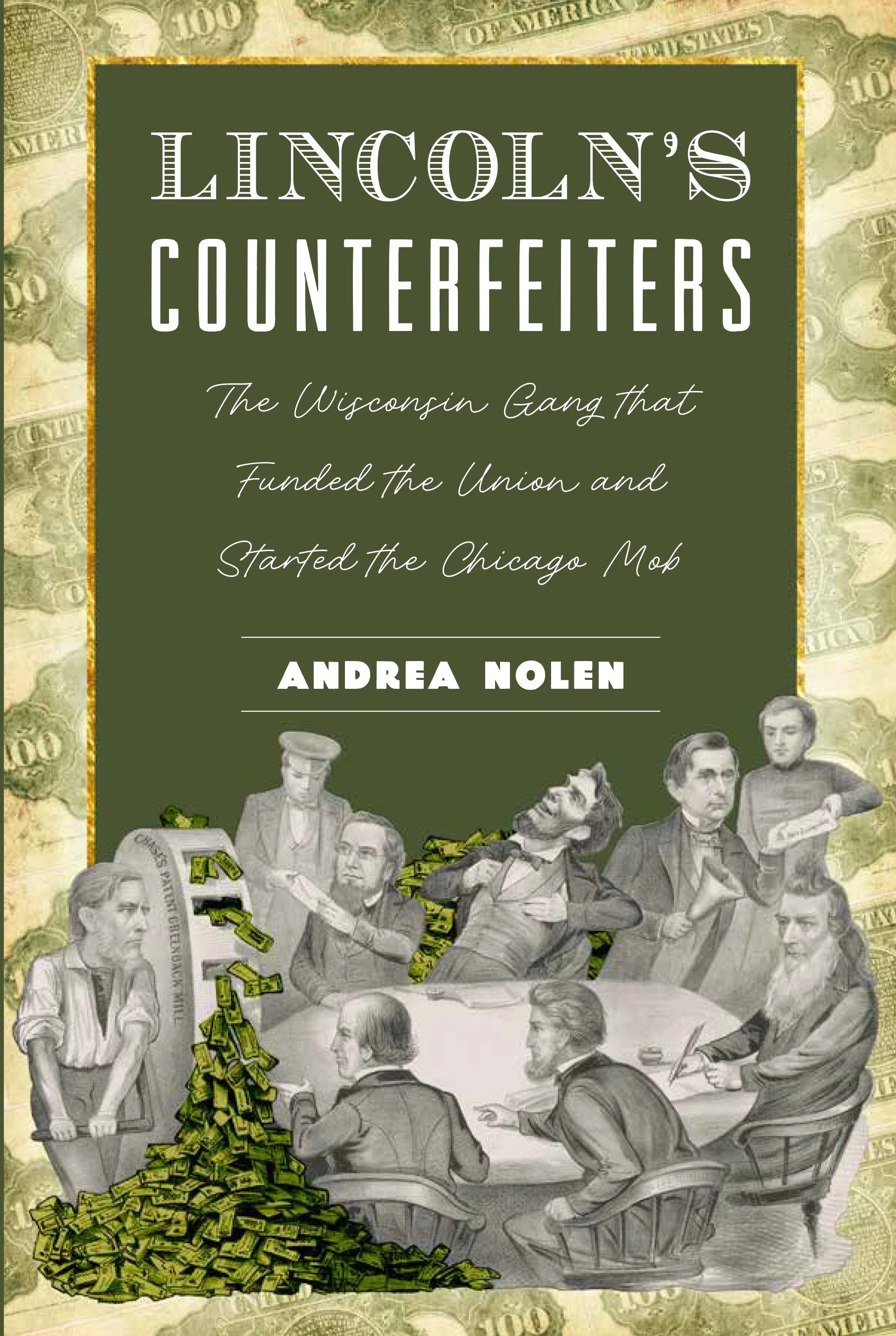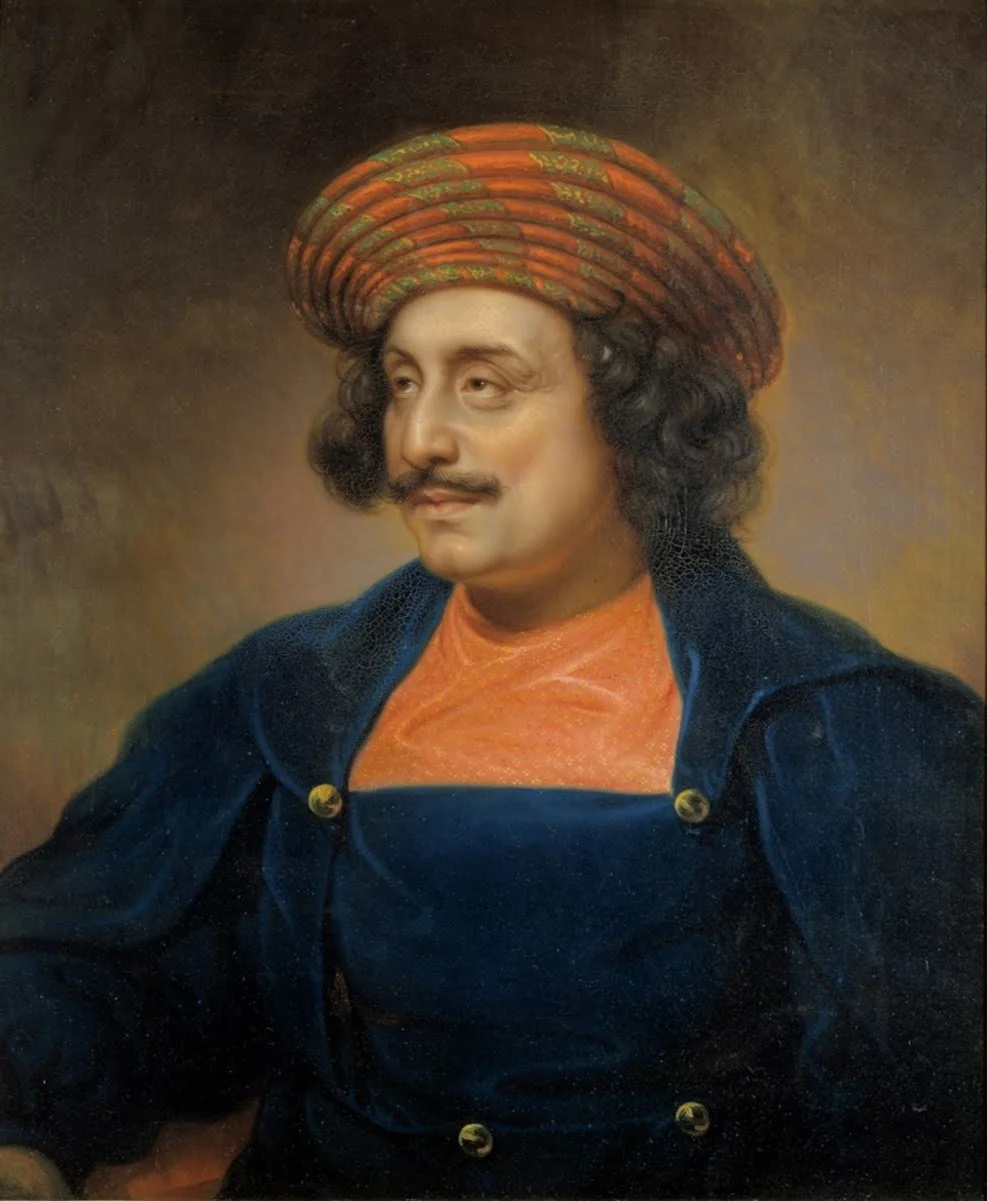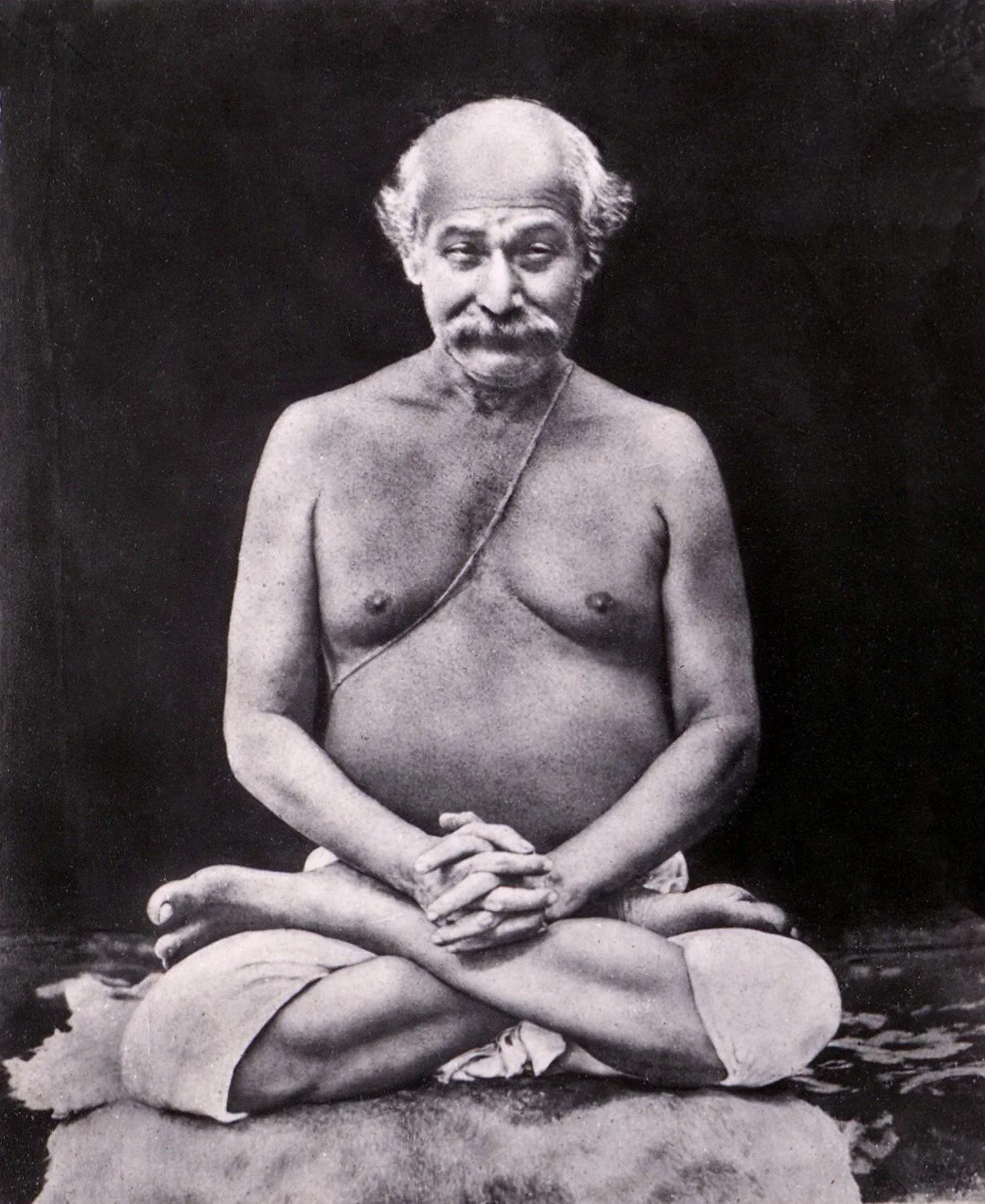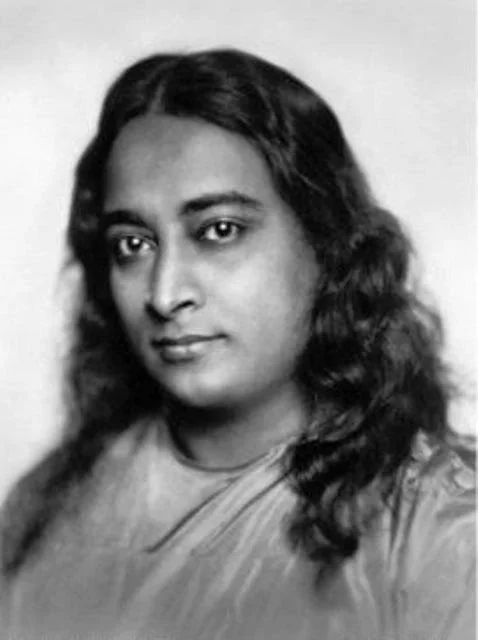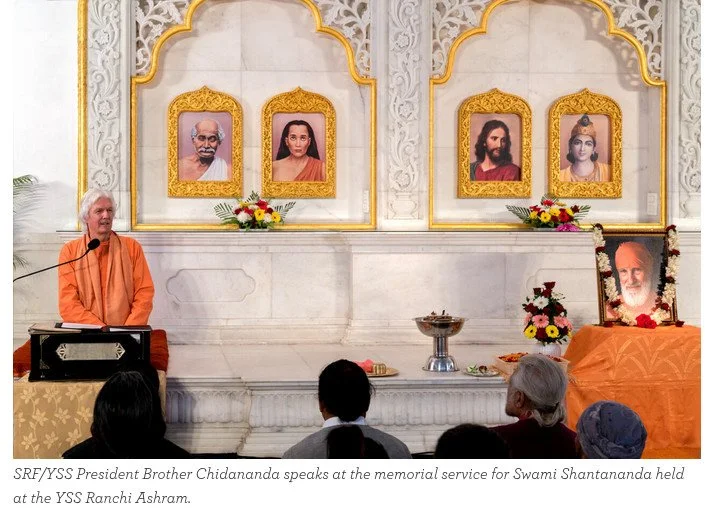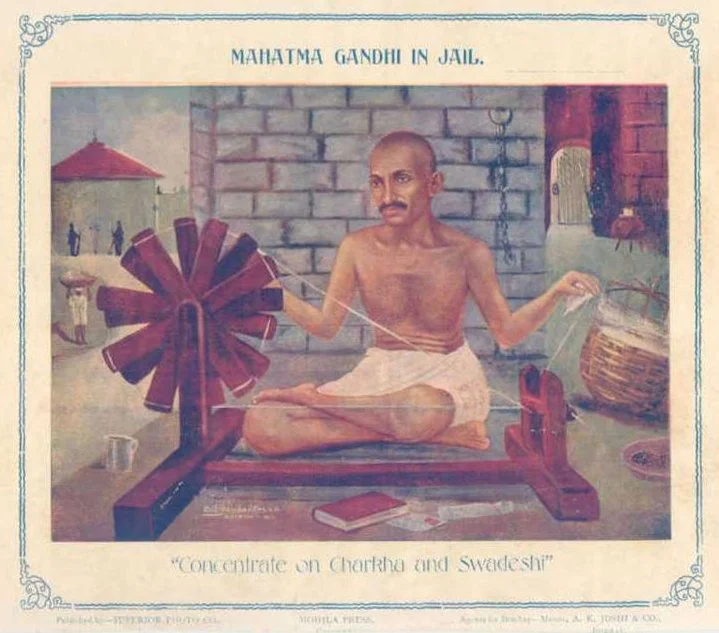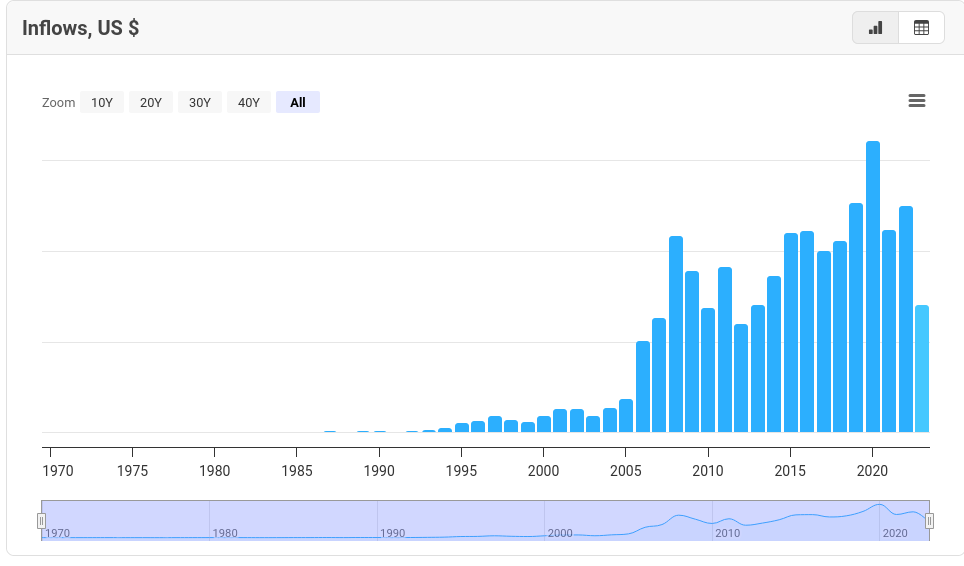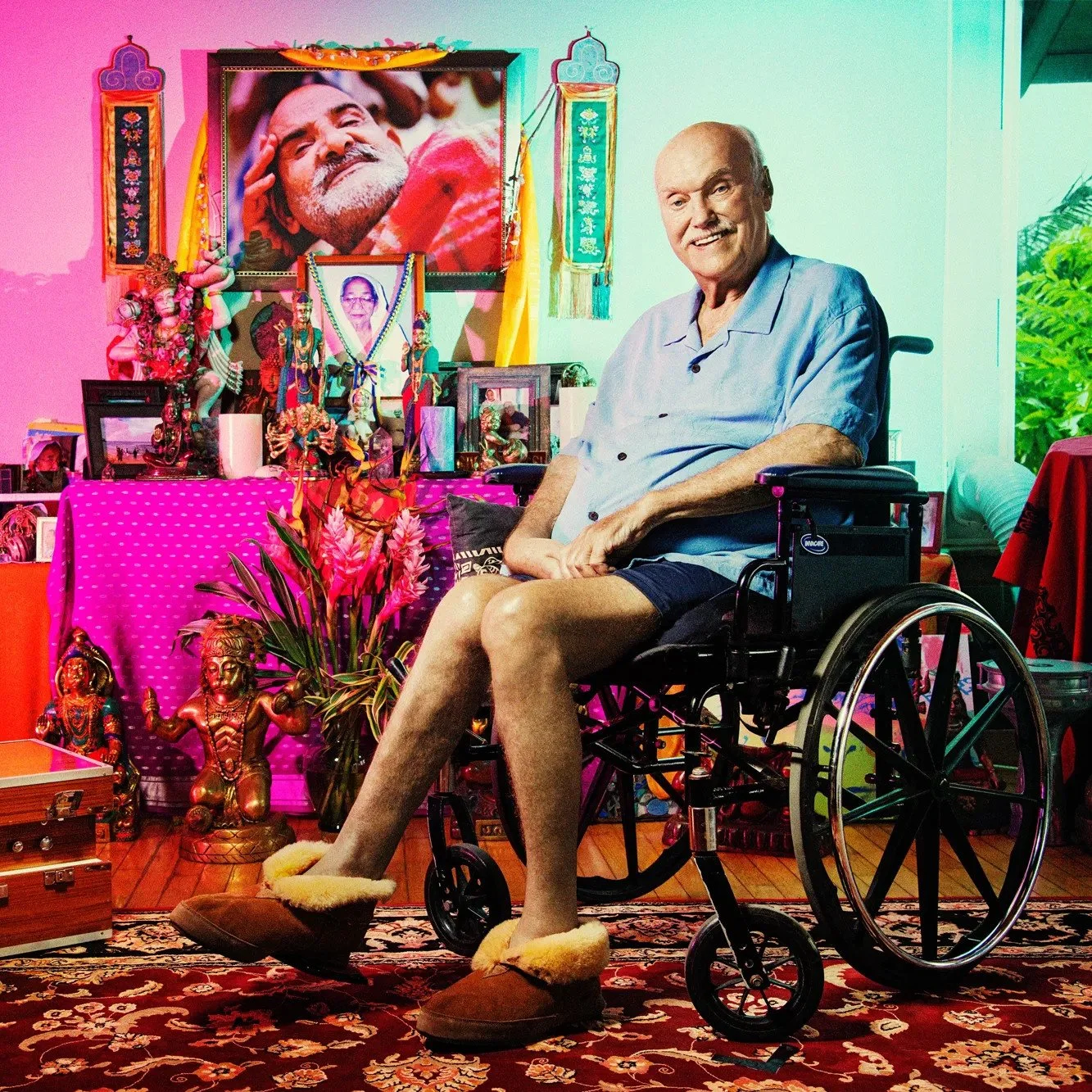Spooks of the Raj: Sgt. Pepper and the New Age Movement
Greetings, readers! First, housekeeping—
My book, Lincoln’s Counterfeiters: The Wisconsin Gang that Funded the Union and Started the Chicago Mob, will be for sale starting August 18th, 2025. I’ll update this post with an affiliate link so you can get a discount. My publisher did a great job on the cover, check it out below.
I will do at least two ‘launches’, one in Monroe and one in Madison WI, so if you’d like to buy a copy from me personally you will be able to. I’ll probably also give a talk and serve Kentucky Colonels. Yay! Details will follow as available.
This post is a ‘big picture’ post that will tie together saffron threads that weave in and out of the Goetz, Bone Latta and “Kentucky Colony” story. These threads are of the occult and universalist-flavored “Hinduism”.
After the US Civil War, Lincoln’s Counterfeiting Gang (the “Bonelattas”) entrenched themselves in regional banking, while the Chicago wing, known as “the Kentucky Colony”, consolidated organized crime and voter fraud in that city. This resulted in the “Democratic Machine” which still controls Chicago. The “Machine” is not a Republican/Democrat thing, it’s a control thing, and by the 1890s these criminals realized “Hinduism” presented them with some useful tools.
Back up a minute here: In the 1820-1880s, Islam captured the minds of empire-minded, Anglo-American religious radicals— the type of person involved with Lincoln’s Counterfeiters. Mormonism, “the Islam of America”, was just the most visible manifestation of this phenomenon. By the 1890s however, Hinduism became radicals’ new enthusiasm. This was painfully evidenced through the Kentucky Colony’s sponsorship of Swami Vivekanada at the Columbian Exposition in Chicago, 1893. Reverberations of this criminal/religious synchronism are seen in the the Sgt. Pepper cover above. That cover image will guide this post: the album cover is like a small ‘Mnemosyne Working’, a magical hermetic working, a forerunner to which I described in this post on Freud and Abby Warburg.
Genesis of the Sgt. Pepper Cover: A Recolonization
Abby Warburg was from a London-based “unorthodox investor” family and Freud was a darling of Warburg’s “unorthodox investor” peers in Vienna. (Peers who by the 1890s controlled the Hapsburg Foreign Office and Vienna’s Medical School.) Chicago was London on Lake Michigan, having taken “unorthodox investor” money for its infrastructure projects. Chicago socialite Bertha Palmer, the star Kentucky Colony daughter, was unorthodox investor Ernst Cassell’s contact/collaborator with King Edward VII until the monarch’s death. (Bertha helped Bertie have illicit sexual flings, not unlike Madame Rachel’s operation decades before.) These Chicago/London connections helped British money buy up Midwestern and Southern assets from “carpetbaggers” after the Civil War. The “Kentucky Colony” were fixers for the cosmopolitan recolonization of the United States by people like Cecil Rhodes and his business circle.
Abby Warburg was a nutball, but his fevered antennae caught cultural currents of his day, perhaps like Kanye West in our time. Warburg’s occult library was and is influential in London’s cultural scene. The designers of the Sgt. Pepper album cover, Peter Blake and (ex) wife Jann Haworth, were simply recycling fashionable and ‘elite’ ideas that Warburg presented a few decades prior through his Mnemosyne Working art installation. (Haworth is from a connected Hollywood family.)
Haworth/Blake’s cover is an ideas map for extending empire beyond the limits of the overt political control “unorthodox investors” in London enjoyed in the 1890s. These ideas first crystalized in the minds of British East Indian Company utilitarians; then in the surreptitious empire-building of Cecil Rhodes and the Kentucky Colony; and most recently in the technocracy of Silicon Valley (which I will explore through Apple Computer and their famous legal wrangling with The Beatles).
To put that album cover in context, I will share a personal story. When I was young, I worked for an American couple in London whose parents were instrumental forming the OSS, then CIA. They ran a hedge fund. The wife was close to the lady who designed those “Sgt. Pepper” jackets for M. Berman Ltd. This designer, who is not publicly credited for her work, was a drinking companion of the then-prime minister Harold Wilson, a Labor politician. Wilson championed policies which are now the heart of “DEI”. My point is that The Beatles were not an organic phenomenon and that they were at the very center of mid-century power. They were “revolutionaries” from the top downwards, as was the Kentucky Colony’s Abraham Lincoln.
Vendanta Hinduism and the Working
Bearing the above points in mind, four of the figures featured on the cover are “Hindu” gurus. I put “Hindu” in scare quotes because they represent a very specific strand of Southeast Asian religious thought that was championed by the British East India Company. I reproduce a wikipedia map of the image below:
Beatles and their wax statues are removed.
(1) Sri Yukteswar Giri (Hindu guru); (27) Sri Mahavatar Babaji (Hindu guru); (33) Sri Paramahansa Yogananda (Hindu guru); (51) Sri Lahiri Mahasaya (guru). These gurus are the only “spiritual” celebrities featured. Lennon wanted Mahatma Gandhi for position (68), leering over the shoulder of Lewis Carroll, but managers thought including Gandhi would make Indian distribution impossible. Lennon also wanted Christ, but again this was “controversial”, because Lennon had said this two years earlier:
When speaking to The Evening Standard in March 1966, Lennon said: “Christianity will go. It will vanish and shrink. I needn’t argue about that; I’m right, and I will be proved right. We’re more popular than Jesus now. I don’t know which will go first, rock ‘n’ roll or Christianity. Jesus was all right, but his disciples were thick and ordinary. It’s them twisting it that ruins it for me.”
Between Lennon and the album cover, I ask readers to note the disrespectful yet nonsensical element. The gurus are the spiritual face of this working.
Who are these gurus and what do they teach? A nineteenth century variation of “Vendanta Hinduism”: a fusion of Hermeticism, Universalism and Calcutta-area Hindusim as approved by the British East India Company’s unorthodox investors. From 1818 the BEIC sponsored this religious soft power exercise to bring Indians in the Raj capital city and expatriate Brits on board with their social and economic reform programs. In the 1800s these ideas were pushed through BEIC-backed educational institutions like the Scottish Church College in Calcutta. By the 1970s the ideas were pushed through intelligence-adjacent mouthpieces such as The Beatles, The Rolling Stones and “guru” cult-leaders in Western power-centers. It was a very cynical undertaking.
The crumbling Scottish Church College in Kolkata (Calcutta), India.
The architects of this BEIC undertaking were men whose names readers will remember from my writing on Lucy Duff Gordon and the Ziegfeld Follies: John Stuart Mill, Jeremy Bentham and their predecessor at the BEIC, Lord William Bentinck and Thomas Babington Macaulay. Bentinck and Macauly inherited a Company structure which tried to work within existing Indian political institutions and buy goodwill through supporting public health and underwriting traditional cultural pursuits. The idea was to flatter and soothe with charitable giving on one hand, while pursuing irritating BEIC business goals with the other. Starting in 1818, Bentinck and Macauly, inspired by utilitarianism, turned this pragmatic ‘soothing’ approach on its head. From The English Utilitarians and India:
“Free Trade was its [Bentinck’s reforms] solid foundation. Evangelicalism provided its programme of social reform, its force of character, and its missionary zeal. Philosophic radicalism gave it an intellectual basis and supplied it with the science of political economy, law and government.”
Utilitarianism, according to dictionary publisher Oxford Languages, is “the doctrine that actions are right if they are useful or for the benefit of a majority.” What that definition leaves out is that the BEIC chooses what is “useful” or of “benefit”.
That Free Trade (for non-aristocrats), evangelicalism, and “philosophic radicalism” would be post-1818 Company policy shows how far foreigners and religious radicals had colonized economic control from London. (If you would like to understand more about the difference between British aristocrats and international merchants controlling the East India Company, see this.)
In the midst of Bentnick’s radical new Company policy, an Indian employee of his firm appeared on the intellectual stage: Ram Mohan Roy. Ram Mohan Roy’s teaching fused Hinduism, Universalism, Islam and its handmaiden Unitarianism while promoting the same Western education policies as the BEIC’s leaders. It was almost as if Ram Mohan Roy was tapped to be the Indian face of Bentinck’s policies. Following Ram Mohan Roy, increasing numbers of Universalist-inspired “Hindu” gurus appear for Indian, and eventually Western, audiences. The Company’s soft-power undertakings were overseen by John Stuart Mill until the Mutiny of 1857, when the rule of India was nationalized.
Ram Mohan Roy, painted by Rembrandt Peale in 1833
““Mill will be the living executive— I shall be the dead legislative of British India.””
John Stuart Mill can be described as the Company’s spymaster for the majority of his tenure in India: he was responsible for managing relations and information flow between the Company and the various Indian states. Mill had an unsavory connection with the Siege of Cawnpore, a key event in the Mutiny of 1857. Cawnpore was a mass-killing initiated by a Company collaborator named Nana Sahib and Mill’s close friend Azimullah Khan. 120 European women and children were massacred because Sahib had been denied a Company pension. Prior to this action, Azimullah Kahn had spent months in London with a family friend of Mill — the spooky "unorthodox investor” Lady Lucy Duff Gordon— building political support for himself. Mill’s political career in England was sunk by the mutiny and he turned to Vienna’s powerful “Ringstrasse” Jewish community for patronage. (The Ringstrasse also supported Oscar Wilde, figure (41).)
So what were the nuts-and-bolts of BEIC utilitarians’ retooling of “Hindusism” for control purposes?
Readers may remember that the religion of Monroe, WI’s elite was ‘Universalism’. Universalism itself is a product of the English Civil War and Cromwell’s Islamification of the English military. That Islamification had Sufi (Islamic mysticism) undercurrents which in turn drew heavily from Hermeticism. Cromwell’s goal was to make himself the ‘one ruler’, a Mohammad-like figure, who commanded temporal and spiritual power over devoted, deracinated troops. (Mohammad and his successors relied on slave armies for their imperialism.) Cromwell also subjugated and enslaved everyone who stood in his way, particularly Irish adversaries who were sold to places like Barbados.
Rev. Mecca E. Varney, one of the early leaders of Monroe, WI’s Universalist Church. Mecca was probably born shortly after the US Civil War. At this time in the USA women “reverends” were exceedingly rare. Today, the Unitarian and Universalist denominations have merged and consider themselves Christian by historical coincidence only— you can be any faith and UU.
Islam is great for imperialists who want to make the military sacrifice of invasion and subjugation/enslavement. But if that’s too costly, then the BEIC’s “Vendanta Hinduism” is a cheaper state religion. Vendanta teaches that men can become gods just like Hermeticism does. In the context of the West, both philosophies appeal to pride while doing away with Christian teaching which set limits on the behavior of men. In the Indian context, the BEIC’s Vendata attacks the foundational beliefs of racial, religious and ethnic clannishness which stood in the way of BEIC profit-making. The cornerstone of BEIC-style Vendanta is Universalism, which simply asserts that all faiths teach the same thing. Universalists tend to appeal to their superior intelligence in defense of this assertion. You all can be gods, you all believe the same thing, regardless of what you believe. In reality, holding contradictory ideas at the same time is bad for peoples’ mental health and I discuss the political utility of people prone to this confusion, the “new people”, here in context of the 21st century “intelligence community”.
Like Hermeticism or Universalism, BEIC-Vendanta teaching has an atomizing affect in communities where it takes root. Trust is undermined when everyone pursues their own interests and invents their own values, as is the ability of social groups to organize and protect themselves. (Want an example? See how the Universalists behaved in Monroe in service to British Imperial interests.)
Rather than strengthen social cohesion, Hermeticism breaks it down. In the words of Picatrix translators Porecca and Attrell, the Hermetic text appeals to people “very cognizant of the need to appeal to social superiors in order to benefit materially or socially” and who want to use deception to achieve Machiavellian ends. The British East India Company realized the value of this atomized thinking in the early 1800s and Universalist/Hermetic/Vedanta-inspired gurus became their propagandists of choice.
Ram Mohan Roy came from a privileged Bengali Brahmin family, but one atomized by religious differences. (His father followed a type of Hindusim that put Vishnu at the head of the pantheon, his mother put Shiva— this caused irreconcilable tension for Ram Mohan Roy who was eventually estranged from his family.) Roy’s sprawling religious quest and embrace of Universalism— as well as the wealth and foreign prestige that came with it— inspired generations of “gurus”.
The first of these “gurus” to reach the West was Swami Vivekananda, who was promoted by the very same organized crime group I write about in Lincoln’s Counterfeiters, Chicago’s “Kentucky Colony”. The Colony was adept at divide-and-conquer political strategies, which they learned from German Europe’s political struggles after 1848. They hit on Vivekanada at a time when Christian social groups were organizing to combat prostitution and sex-trafficking, which funded the Colony’s “Democratic Machine”. The Colony provided Vivekandanda with a stage at their 1893 Columbian Exposition, from where his proselytizing launched “yoga” and the New Age movement, which in turn reached a kind of crusty head with The Beatles. (You can read all about the Columbian Exposition and its relation to sex trafficking in Lincoln’s Counterfeiters.)
Narendranath Datta, who took the name “Swami Vivekanada” was born into a privileged Bengali family near Calcutta. His family’s caste was a scribe-caste, the “Kayastha”, which was Brahmin-like but not quite as high status as the Brahmin. Bickering between these competing high-status castes caused endless political problems (and opportunities) for the British.
Vivekananda’s legacy is not great. The Swami is credited with laying the foundation for creepy cults like “Transcendental Mediation”, a pseudo-scientific mental health treatment that is heavily funded by the US military, the leaders of which faced sexual and financial abuse allegations. Hindu nationalists also claim the swami, who was courted by Gandhi for his political machinations. Gandhi was violently racist against Black Africans during his time in South Africa. The aggressive, coercive Modi government is simply the logical conclusion of Gandhi’s path for India.
Ram Mohan Roy’s guru machine produced other universalist ‘adepts’. For example, Lahiri Mahasaya, who is figure (51) on the Sgt. Pepper cover. Just like Ram Mohan Roy (and sorta like Vivekananda), Lahiri Mahsaya came from a Bengali Brahmin family. Allegedly, Lahiri Mahsaya met a god in a cave: the god was named was Mahavatar Babaji and is Beatles figure (27). Babaji allegedly taught Lahiri a special type of yoga which had been lost to mankind for centuries. This “Kriya Yoga” became the basis of Lahiri’s cult and he focused on recruiting rich adepts from Calcutta, the Bengali city which was the capital of British India.
Lahiri Mahasaya, a Beatles Guru… or a British Stooge?
I find the guru who succeeded Lahiri, Sri Yukteswar Giri, fascinating because his cult-teaching drew so blatantly from Hermeticism and particularly the Picatrix, which was an influential text in London and Vienna at the same time that Beatles/BEIC gurus were appearing. Sri Yukteswar Giri is Sgt. Pepper image (1). In 1894— one year after Vivekanada’s showing in Chicago— Mahavatar Babaji [image (27)] also appeared to Giri and told him to write a book comparing Christian and “Hindu” doctrines in a Universalist light! (Did Babaji ever appear to Bentinck, I wonder?) Giri wrote just such a book, titled The Holy Science, which purports to show the unity of all religions. Like the Picatrix, The Holy Science promotes astrology and reinterpretations of Greco-Egyptian “Humoral Theory”. Giri also ascribed magical powers to precious stones. (Read all about the Picatrix and Empress Elisabeth in Vienna.)
Fortunately it’s not a long book.
Remember these? That’s a heremtical talisman straight out of the Picatrix. The same Greco-Roman magical ideas have been adopted by Hindu astrologers, including Swami Sri Yukteswar.
“Scientific” approaches to Christianity were popular in the 19th century, as Mary Eddy Baker’s “Christian Science” movement attests. Interestingly, Baker’s cult took root around Boston, MA where the BEIC gurus found ready promoters among Unitarians (Islamic Christianity) in particular. More generally, charlatans of the era— be they medical, or religious, or otherwise— liked to exploit the public’s association of ‘science’ with ‘truth’. Also interestingly, when Sri Yukteswar Giri’s hermetic “science” was infiltrating the West, Aby Warburg scholars like Frances Yates were making careers claiming Hermeticism powered Europe’s Scientific Revolution. (These claims are no longer in vogue.)
All these BEIC gurus worked around Calcutta, and there Giri [image (1)] spawned “Paramahansa Yogananda” [Sgt. Pepper image (33)]. Yogandanda met his guru Giri in the weeks following his graduation from the Scottish Church College, which had recently launched Swami Vivekananda’s career too. Yogananda’s birth name was Mukunda Lal Gosh and his parents came from the Bengali Kayastha caste, just like Vivekananda. (The gods display remarkable geographic and socioeconomic favoritism!) Yogananda’s dad was the vice president of the Bengal-Napur Railway during the last decades of the Raj. Yogananda was the guru who the Cecil Rhodes set would send to California.
Paramahansa Yogananda in his trademark pose.
Yogananda had remarkable access to the corridors of American power and even met President Calvin Coolidge in 1927. The chubby guru lived a life of luxury in the USA thanks to his wealthy followers, but allegations of financial and sexual misconduct dogged him as they have so many gurus in the West and in India. His estate is managed by Western adepts as the “Self-Realization Fellowship” and operates several luxuriant campuses in California. A handful of Gandhi’s ashes is on display in their Fellowship Lake Shrine in Pacific Palisades, California. Their recruiting efforts have focused on movie stars (Pamela Anderson, Greta Garbo, Robin Williams); wealthy business people (Doris Duke, Luther Burbank); and music biz personalities (Madonna, Elvis, George Harrison). The followers of Yogananda are able to hold multiple contradictory beliefs at once, for instance, that one can be a polytheistic Hindu and a monotheistic Christian at the same time. I wrote about this “new person” and their usefulness in Washington D.C. in my post Liquor Men to Movie Men.
Gateway to one of the Californian “Self-Realization Fellowship” campuses, thank you SoundReasonAndMore.
Photo from a Self-Realization Fellowship memorial service. Beatles gurus on LHS.
As an aside, Bikram Choudry, a Calcutta-born ‘hot yoga’ celebrity, claimed Yogananda’s younger brother as his guru. Bikram was the subject of a 2019 Netflix documentary titled Bikram: Yogi, Guru, Predator. He appears to have fled to India to escape rape charges in the United States.
The temporal power behind Yogananda interests me more than any spirituality he claimed, so I’d like to look at the comrade he left behind in India, Manamohan Mazumder. Mazumder was a childhood friend of Yogananda (he lived across the street from Yogananda’s rich family) and was also a disciple of Swami Sri Yukteswar Giri. However, while Yogananda went prospecting in America, Sri Yukteswar Giri dubbed Mazumder “leader of the East”. Mazumder took on his guru name of “Swami Satyananda Giri” and opened many yoga schools in the Bengal region of India.
Who funded Swami Satyananda Giri? Until the late 1940s, it was the Maharaja of Kashimbazar, Lord Manindra Chandra Nandi. Nandi too was born in Calcutta and adopted by the widow of Raja Krishnath Roy of the Cossimbazar estate, so that Nandi would inherit. This makes him a financial beneficiary of the British and their vassal landowners. Yet, Nandi became a “prominent figure in India's freedom movement” and actively promoted Gandhi at the Hindu educational organizations Nandi funded. Nandi took on the title of “Maharaja” and became an industrialist in the 1900s.
“During the tumultuous period of the Bengal Partition in 1905, Nandi played a pivotal role in shaping the Swadeshi movement… The establishment of Bangalaxmi Cloth Mill in January 1906 marked a significant milestone in the Swadeshi movement, further solidifying Nandi's leadership.”
The “Swadeshi Movement” was Gandhi’s springboard to political prominence and power. The movement’s goal was economic independence from Britain, particularly in the cloth trade. The movement only really gained traction after Lord Curzon (Lucy Duff Gordon’s sister’s lover) announced the partition of Bengal. Gandhi himself encouraged the burning of British goods (not just passports!) and promoted similar acts all over India. At a higher level, such acts were key to Gandhi’s (or his handlers’) goal of promoting a United India and nationalist consciousness— ideas that are totally foreign to India’s history, but not to Europe’s.
With the benefit of hindsight, we can see that Gandhi’s ‘Hindu Nationalism’ has brought India to greater dependence on money-men in London than ever before. Gandhi himself received a great deal of promotion from CIA mouthpiece Time/Life magazine (owned by Claire Boothe Luce) during his political career.
Foreign Direct Investment into India, 1970-Present. macrotrends.net


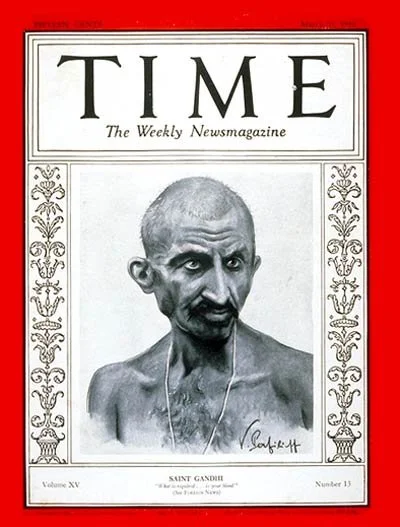

Spook Rock Bands and the Technocracy
In 2011 Apple Computer head Steve Jobs instructed copies of Yogananda’s book Autobiography of a Yogi to be given to all attendees of his memorial service, including Salesforces’ Marc Benioff. Jobs claimed to have read the book multiple times throughout his life.
As it turns out, Silicon Valley’s favored sons are heavily invested in the yoga gurus of the 1960s and 70s. Larry Brilliant, one of Jobs’ friends, traveled with Jobs through India in 1974. Much like the pre-1818 British East India Company, Brilliant made a career out of traveling the subcontinent bestowing public health charity. He headed Google’s charitable giving, and oversaw eBay head Jeff Skoll’s charitable giving, and even worked for the WHO. (He believes the WHO didn’t declare COVID 19 a pandemic quickly enough.) Larry’s wife Girija (Sanskrit name) was born “Elaine” and BEIC “Hinduism” plays a large role in their spiritual life.
I’d like to remind readers that Salesforce, Google and Apple are among the tech companies outed for working with the NSA to spy on Americans, and on anyone else whom they deem of interest through their own secret deliberation processes, thanks to overseas partners like Britain’s GCHQ (based in Cheltenham, Gloucestershire).
It’s particularly weird that Jobs and his set should latch onto The Beatles’ guru lineage because of the bad blood that existed between Apple Computer and the Fab Fours’ holding company, Apple Corps. Apple Computer was involved in a drawn out legal battle with Apple Corps because Steve Jobs stole Apple Corps' name in 1976. According to The Guardian:
“The dispute dates back to 1980 when the late George Harrison noticed an advertisement for Apple Computers in a magazine and argued there was a potential for trademark conflict with Apple Corps.”
Jobs was in fact stealing from some really, really powerful people. (He probably knew it— but perhaps he had powerful investors on his side too!) The Beatles were financially connected to companies with close ties to British military and propaganda concerns-- spooky concerns.
The Beatles’ financial manager Allen Klein employed two merchant banks for them: 1) Klein shepherded the band’s investments through Ansbacher and 2) the holding company for exploiting the band’s early songs (Northern Songs) was managed by Slater Walker.
In 1969 trade publication Cash Box described Ansbacher as “the Beatle merchant Bankers”. Ansbacher was not a warm, fuzzy institution. In 2007 it was revealed that the bank was the lynch-pin in a nasty arms dealing scandal, according to The Guardian:
“The arms company BAE Systems used a secret payments system to transfer more than £13m to a company linked to David Hart, the controversial former Conservative defence adviser, according to legal sources.
He has acted as a lobbyist both for Britain's biggest arms company and also for the giant military manufacturer Boeing in the US.
Mr Hart, an Old Etonian who lives in a Suffolk mansion, became notorious in the 1980s for helping the then prime minster Margaret Thatcher break the miners' strike in an operation he ran from a luxury suite at Claridges hotel, in London.
BAE is alleged to have paid the money into a previously unknown offshore company linked to Mr Hart called Defence Consultancy Ltd (DCL).
The company was registered anonymously in 1997 in the British Virgin Islands, with a bank account in the Channel Islands tax haven of Guernsey, at the Henry Ansbacher merchant bank. Mr Hart's late father, Louis "Boy" Hart, was the bank's chairman.
This is the latest allegation to emerge from corruption investigations into BAE, being conducted by prosecutors from three countries - Switzerland, Sweden, and the Serious Fraud Office in the UK.”
Ansbacher hit troubled waters in 1993, when the Apartheid-era South African spin-off of the British Barclays National Bank, First National, bought the bank. (This British-derived concern seems to have done well in the fall-out from the 1994 regime change.) During negotiations it emerged that Swiss firm Pargesa Holdings owned 62% of Ansbacher. Pargesa is a very prominent multinational specializing in fossil fuel investments, with huge stakes in Total S.A. and Suez S.A. (which controls about 50% of the globe’s major cities’ water supply), amongst other energy and mining firms. The Guardian goes on to state:
“Ansbacher has at times been tinged by scandal: Lord Spens, a former director, was involved in the Guinness affair, and its current chairman advised Robert Maxwell on a deal now being investigated by the Serious Fraud Office. The merchant bank made a pre-tax loss for 1991, but a small pre-tax profit in first half of 1992.”
The Guinness Affair involved artificially raising the price of Guinness stock in anticipation of buying out another distillery; the scandal epitomized rampant corruption in London's financial sector. Robert Maxwell, born Ján Ludvík Hyman Binyamin Hoch, was one of many powerful post-WWII British subjects to escape Nazi persecution. Maxwell was also a disgraced publishing magnet and embezzler, whose daughter Ghislaine is doing jail time for procuring underage girls for Jeffery Epstein’s (Israeli intel, CIA-tolerated) kompromat operation.
Ghislaine, Robert and wife Elisabeth, a prominent Holocaust researcher in France. After Robert’s death the Duke of Westminster (Gerald Grosvenor) kept Elisabeth in the style to which she was accustomed in one of his Pimlico Road properties.
In 2002, Ansbacher made the Irish press for all the wrong reasons:
“At the centre of the scandal is Ansbacher, an international group of “boutique” banks specialising in “wealth preservation” for the super-rich. In Ireland Ansbacher and its predecessors ran an illegal banking operation that helped a select group of the well heeled and politically connected, the so-called “golden circles”, to dodge tax over the course of two decades.”
The Beatles chose some pretty ugly people to manage their affairs, and hardly people who fit in with the band's 'love & peace' image. Unsurprisingly, the investment bank advising Northern Songs shareholders, Slater Walker, was no better. The bank collapsed in 1975 after its founder Jim Slater misused millions of GBP manipulating share deals, Slater was replaced by the equally corrupt playboy and Anglo-French billionaire financier Jimmy Goldsmith after a Bank of England bailout. (Jimmy's daughter Jemima is famous for her strange, failed marriage to jailed Pakistani politician Imran Khan.)
Which companies did Slater Walker advise as shareholders in early Beatles intellectual property? Cash Box tells us: “Hambros, Howard and Wyndham, EBOR and Invan Unit Trust”.
Hambros: was a UK-based bank that specialized in flogging British Government debt to various Scandinavian countries and financing the ugly diamond trade-- you needed high-level connections to set up a concern like Hambros, which is now part of Société Générale.
Howard and Wyndham: was a huge British media concern, specializing in theaters which featured live plays-- an important propaganda vehicle in the U.K..
EBOR Unit Trust: was a British life assurance concern-- a sort of mutual fund rolled up with an insurance company. The British insurance industry is not very transparent and is dominated by Lloyds of London, an insurance market that is a quasi-governmental organization in its own right and has always been at the heart of British power circles.
INVAN Unit Trust: was set up by Slater Walker to elbow in on the life assurance business, presumably they paid Slater Walker for investment advice too.
None of these firms held the philosophy that “all you need is love”, but they were all clued into a smart investment that even John Lennon didn't fully understand. Apple Corps would never gain control of the rights to early Beatles songs, these rights would eventually pass to the late Michael Jackson and his partnership with Sony Music.
Jobs certainly knew about the Beatles' corporation when he chose “Apple”, and American trademark law was well established by that time, so it was a very odd thing for Jobs to do. What is even more odd is that Apple Computer Inc. has won every trademark battle brought by Apple Corps in defense of its name-- there have been three separate series of litigation over the decades. By 'won' I mean each case was settled in Apple Computer's favor.
Considering that Jobs actually stole a trademark from one of the most popular music groups in history, a band with the British (and Israeli?) establishments behind them, the $29 million Jobs paid out is pretty paltry. However, it's $29 million that Apple Computer didn't need to loose-- why not 'Banana Computer', or 'Grapefruit Inc.'?
For a long time, Jobs refused to give an answer. Then, after the third settlement, he revealed that he chose 'Apple' because he was on a freakish, all-apple diet at the time of the company's founding. Needless to say, that stinks worse than durian.
I don't think that Jobs was a stupid man; I think his lawyers would have advised him against naming his company after the Beatles' firm in any ordinary situation. I don't think that the founding of Apple Inc., one of the NSA's corporate spying buddies, was an ordinary situation for reasons I've detailed above. The Beatles were financially connected to companies with close ties to Anglo military and propaganda concerns-- spooky concerns. But Jobs himself was the kid of a Syrian Las Vegas casino owner and political science professor Abdulfattah John Jandali. Jandali made money managing restaurants in Meyer Lansky country, which I’m sure has nothing to do with money laundering. But hey, everybody enlightened has the same religion!
There is one guru who is notably absent from the Beatles cover, Neem Karoli Baba. (From Larry Brilliant’s Seva.org video above.) In his early years Baba was exclusively promoted by spooky, Laurel Canyon-domiciled, MK Ultra-style Americans and he was not from Calcutta, but Uttar Pradesh (central India, right up next to Nepal). I need to talk about him in another post, as well as the remaining Hollywood, boxing and Rolling Stones avatars on the Sgt. Pepper cover. The Galician Gang (Robert Maxwell types) are the unifying factor.
Read all about their Chicago patrons in Lincoln’s Counterfeiters this October!


